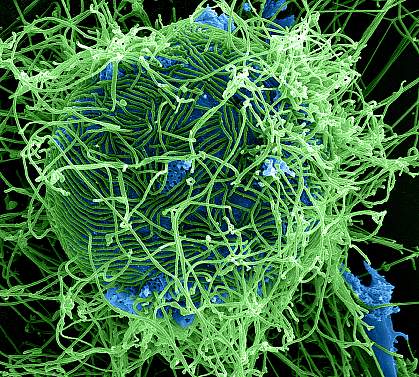You are here
September 15, 2014
Genetics of the 2014 Ebola Outbreak
At a Glance
- Scientists used genomic sequencing technologies to identify the origin and track transmission of the Ebola virus in the current outbreak in Africa.
- The insights may help guide many aspects of the public health response.

The Ebola virus can cause severe illness and death in people and other primates. The 2014 Ebola outbreak is the largest outbreak in history, with more than 3,600 infections and 1,800 deaths as of the end of August, according to the World Health Organization. The outbreak is the first in West Africa and the first to affect major cities.
Once Ebola virus has been transmitted from an animal host to a human, it can spread through person-to-person contact. Symptoms usually appear 2 to 21 days after exposure. Infection can cause fever, headache, body aches, weakness, stomach pain, and lack of appetite. Later symptoms include vomiting, diarrhea, rash, impaired kidney and liver function, and in some cases, internal and external bleeding (hemorrhage). There are no approved drugs for the disease, but prompt diagnosis and aggressive supportive care can improve survival.
To better understand this outbreak, an international team led by Dr. Pardis Sabeti at the Broad Institute and Harvard University collected virus samples from 78 patients living in Sierra Leone near the origin of the 2014 outbreak. The researchers used advanced technologies to quickly and accurately analyze the viral genomes. The work was funded in part by NIH’s Common Fund and National Institute of Allergy and Infectious Diseases (NIAID). The findings were published in Science on September 12, 2014.
The researchers sequenced 99 Ebola virus genomes in total, as some people were sampled more than once. The analysis revealed more than 300 genetic differences from viruses responsible for past outbreaks. The strain responsible for this outbreak appeared to diverge as early as 2004 from one found in Central Africa, indicating movement from Central to West Africa over the span of a decade.
The team also found more than 50 mutations that arose as the outbreak spread. They estimated that the first infection from an unknown source in late 2013 was followed by exclusive human-to-human transmissions. The virus was brought into Sierra Leone by 14 people who had been in nearby Guinea to attend the funeral of a traditional healer who had treated Ebola patients.
The team released all its sequence data as it was generated to aid in relief efforts and speed global research. “By making the data immediately available to the community, we hope to accelerate response efforts,” Sabeti says.
This study highlights the need for continued “genomic surveillance” to track and try to slow the evolution of this virus as the outbreak continues. Understanding the genetics of the virus will also help in the development of new and improved drugs and vaccines.
NIH has been playing a key role in investigating potential Ebola vaccines and medications. It recently announced the launch of an early-stage trial to begin human testing of a candidate vaccine.
Related Links
References: Genomic surveillance elucidates Ebola virus origin and transmission during the 2014 outbreak. Gire SK, Goba A, Andersen KG, Sealfon RS, Park DJ, Kanneh L, Jalloh S, Momoh M, Fullah M, Dudas G, Wohl S, Moses LM, Yozwiak NL, Winnicki S, Matranga CB, Malboeuf CM, Qu J, Gladden AD, Schaffner SF, Yang X, Jiang PP, Nekoui M, Colubri A, Coomber MR, Fonnie M, Moigboi A, Gbakie M, Kamara FK, Tucker V, Konuwa E, Saffa S, Sellu J, Jalloh AA, Kovoma A, Koninga J, Mustapha I, Kargbo K, Foday M, Yillah M, Kanneh F, Robert W, Massally JL, Chapman SB, Bochicchio J, Murphy C, Nusbaum C, Young S, Birren BW, Grant DS, Scheiffelin JS, Lander ES, Happi C, Gevao SM, Gnirke A, Rambaut A, Garry RF, Khan SH, Sabeti PC. Science. 2014 Sep 12;345(6202):1369-72. doi: 10.1126/science.1259657. Epub 2014 Aug 28. PMID: 25214632.
Funding: NIH’s Common Fund and National Institute of Allergy and Infectious Diseases (NIAID); National Science Foundation; European Union Seventh Framework Programme; World Bank; and the Natural Environment Research Council.
